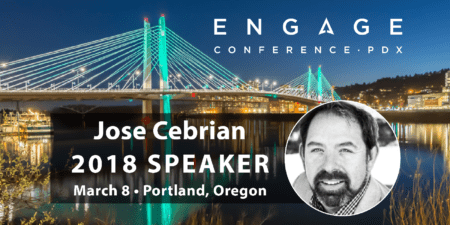Jose Cebrian will be speaking on Email Marketing at Engage 2018, which will take place March 8th, 2018 in Portland, Oregon. For more information or to purchase tickets, please click here.

1) Please give us your background and let us know what you do for a living
I’ve been with Merkle for 3.5 years, as SVP, Digital Messaging, which includes email, SMS, push, and in-app messages. In my role, I am charged with driving innovation inside of our client base, working in tandem with our dedicated account teams. Before joining Merkle, I spent nine years in various roles at Acxiom, most recently as Managing Director, Global Client Services for Digital Impact, Acxiom’s email and SMS division. There, I led the services team across creative, strategy, analytics, and production. Earlier positions include three years at Gartner, marketing their consulting division and managing a team of Java developers at q2 Technologies. I got my start at AGENCY.COM, where I learned the mechanics of the Internet – a skillset that has served as an invaluable foundation for all of my subsequent career roles.
2) When looking over the sales funnel with an eye towards adding some email triggers…what are logical points in the funnel where such a tactic is optimally effective?
Defining triggers as explicit customer actions or propensities that prompt an automated campaign, I would say the following:
At the top of the funnel, the key is to get the person to progress from exploring/searching to take a more defined action. So, the approach differs, depending upon whether or not you know the customer at this stage.
If you don’t know the customer, you need to get in front of them and capture that email address – for email, of course, but also for search, addressable display, and cookie onboarding. An interstitial that mixes a clear value proposition and incorporates some personalization (e.g., references an item a person looked at) works best. From there, you want to trigger a welcome email that supports the value proposition laid out and sets the brand promise for the email program.
If we know the customer, site abandon triggers are an important arrow in your quiver. In this situation, you leverage the fact that someone viewed something on the site, and the email trigger adds value to that interaction. For example, it may describe in more detail the value proposition for the product or service viewed by the customer. It is important with any sort of trigger to be focused on what you want them to do and focus your email on that task. Adding more options can distract the customer from what you want them to do.
A step deeper than the site abandon trigger is an incomplete action trigger. Most people think of these as cart abandon triggers, but it doesn’t have to apply to retail only. It can also be an incomplete form signup/document download/video start, etc. that you want someone to come back and complete.
Once you get into an online conversion, you have all the transactional messages, including confirmations, shipping notifications (if applicable), back-order updates, and so on. For some industries and products, follow-ups such as surveys or ratings are also applicable.
Outside of these common triggers, the following should also be part of any email program:
Re-engagement emails – sent when someone crosses your threshold for being inactive in your email program.
Product replenishment emails (if applicable) – sent to spur a replenishment activity based on either individual or common replenishment cycles.
Customer service follow-ups such as chat to email. When a conversation/chat is complete, trigger an email with the content of the chat or as a follow up to the call.
3) What types of businesses can benefit from a text message strategy and what are some good triggers for sending texts out?
This is a pretty broad question that really has two critical dimensions:
Do you have the opt-in for SMS – this is important, as many companies have not been actively asking for mobile phone numbers for marketing purposes.
Do you have something important to say? SMS should be used for time-sensitive communications – fewer than 24 hours to act. It’s not that precise but the point is urgency.
With those dimensions in mind, you still have all of the email triggers mentioned above, in addition to opportunities for onsite messaging. In-person interaction points, such as hotels, events, casinos, restaurants, grocery stores, etc. are great places to promote or to tell a customer their room, table, or take-out order is ready.
In the case of short/flash sales, SMS can be a driver of activity, but you need to make sure that your digital buying experience is strong.
Todd Mintz knows PPC…knows Social Media…knows SEO…knows Blogging…knows Domaining…and knows them all real well. He runs growth marketing for )and is also a Director & Founding Member of SEMpdx: Portland, Oregon’s Search Engine Marketing Association, and he can be found here on Twitter and Facebook.
